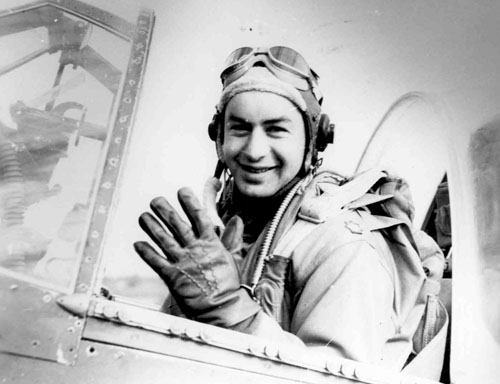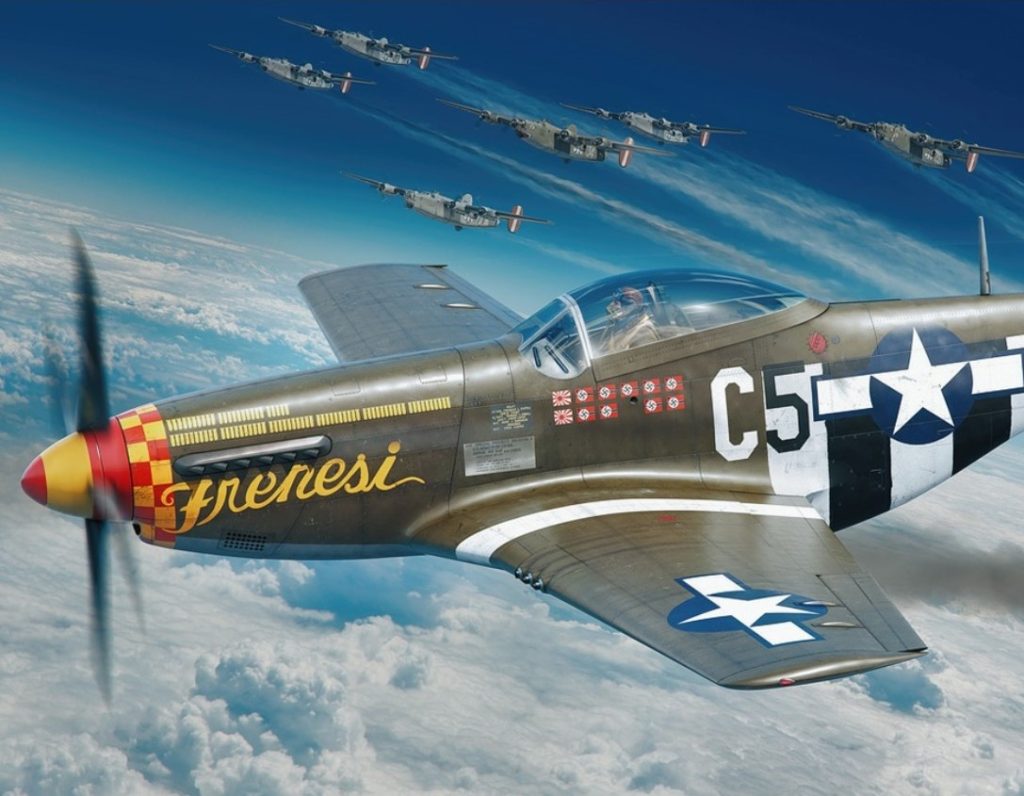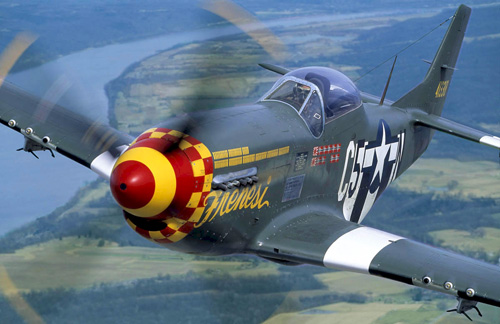TOMMY HAYES: FROM BALI TO BERLIN
Interview by Jon Guttman
One of the more remarkable transformations during WW II was that of the United States Army Air Forces (USAAF) from an unprepared target for the Japanese onslaught of December 1941 to the most powerful strategic air arm in the world in 1945. For the most part, the USAAF could attribute its aerial supremacy to a new generation of pilots, trained by the wizened survivors of the dark early days of the war. One of the rare exceptions is Brig. Gen. Thomas L. Hayes (USAF, Ret.), a fighter pilot whose combat career spanned that entire period. In a recent interview Hayes described what it was like in the Pacific in 1942 and on the offensive over Europe in 1944.
JG: What led you into aviation?
TH: I was born in Portland, Oregon on March 31, 1917, and I was 10 years old when the business of aviation became of prime interest to me. It was in 1927 that Charles Lindbergh, having flown solo from New York to Paris, was touring the US, and I had the opportunity of reaching out and almost touching him as the parade passed within a few feet of my position on the curb. Inspired by his flight, with the subsequent exploits of fliers like Roscoe Turner, Jimmy Doolittle, and Amelia Earhart, and before them the aces of WW I, I couldn’t wait to become an aviator.
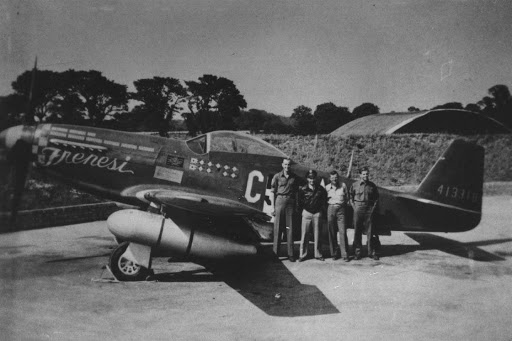
JG: What were your first steps into the air?
TH: After graduating high school in 1935, I tried to enlist in the Navy and become a carrier pilot. I was told that the number one requirement was to have a college degree, so I enrolled at Oregon State College (now University).
JG: Did the outbreak of WW II affect things any?
TH: Yes. In May 1940 the war in Europe was taking a decided downturn. The US was tooling up its aircraft industry, primarily for lend-lease against Germany, and production of aircraft exceeded the production of pilots. At the same time, the college requirement was lowered to two years.
JG: Why did you join the Army instead of the Navy?
TH: In mid-May 1940 an Army Air Corps unit landed at our campus. Two Douglas B-18 bombers escorted by six Curtiss P-36 fighters put on quite an air show. After landing, they set up card tables and a sign saying “Uncle Sam Wants You.” I enlisted on the spot, reported for duty at Vancouver, Washington, barracks, and within a few weeks began training at a new primary training school at Glendale, California.
JG: What was training like?
TH: One underwent three training phases: primary, basic, and advanced. It lasted about nine months. Preflight training was accomplished between flights, with half a day devoted to flight training and half a day to ground school. Flight training was in Boeing-Stearman PT-17s, and within a week I was flying with an instructor.
JG: Did you have any problems?
TH: At first I was unsure, then confident, then overconfident. Once, on a solo flight returning to base, I checked the traffic, entered final approach to land to the north and found PT-17s coming at me head-on. I’d failed to notice that traffic had been changed 180 degrees. My instructor was quickly on me: “Get your head screwed on and quick! The check-ride officer is waiting for you in his ‘washing machine’ to give you a ride.” After that, I was still in the class. In primary, the elimination rate was very high, and the tension of knowing that was a psychological handicap, hanging over the student’s head.
JG: Was it like that once you passed primary training?
TH: No, in basic the emphasis was on making a better pilot and officer. The elimination rate was greatly reduced. I went to basic at Randolph Field near San Antonio, flying the Vultee BT-15. For advanced training I moved across town to Kelly Field and flew the North American AT-6.
JG: Where did you go from there?
TH: I graduated on February 7, 1941, and was assigned to the 35th Pursuit Group at Hamilton Field, California. It was a new group equipped with old Curtiss P-36s. Also based there was the 20th Pursuit, a high-priority group that was upgrading to Curtiss P-40Ds and Es. We inherited their old equipment, P-40Bs.
JG: What was your impression of the P-36?
TH: It was a real fun airplane, good for aerobatics, and excellent for moving from AT-6s to P-40s. One should know that to create the P-40, Curtiss-Wright dropped the air-cooled radial engine of the P-36 and installed the long, water-cooled Allison. That of course moved the center of gravity forward. The P-40 was much heavier, and visibility was somewhat restricted with that extended nose. The P-40 also had more difficult landing characteristics than the P-36—its greater weight, combined with the narrow landing gear and long nose, gave it a greater tendency to groundloop.
JG: What was your state of readiness when the Japanese attacked Pearl Harbor?
TH: By then I had accrued about 300 hours in the P-36 and early model P-40s and I felt I could fly a P-40 as well as anyone. The most serious deficiency in my training was gunnery. The only time I had squeezed the trigger on a machine gun was strafing an oil slick dropped in the Pacific Ocean a few miles from Hamilton Field. Tactics were a close second.
JG: Where were you sent when war broke out?
TH: In late October the 35th had been ordered to the Philippines as part of the buildup there. On December 7 about one-third of the group was at Clark Field, one third at sea and the last third was about to board ship and sail on December 8. I was in the last echelon. There was a regrouping and we departed in mid-December on the commandeered liner President Polk. On board were 55 crated P-40s, 55 pilots, 55 crew chiefs, and 55 armorers. The scheme was to get to Mindanao but it proved not possible and the ship was diverted to Brisbane, Australia.
We immediately set about making the crated P-40s flyable. We had three teams operating around the clock. The crew chiefs were in charge. My job was using a torque wrench. In January 1942 we were joined by experienced fighter pilots evacuated from the Philippines by PT boats and submarines: Charles A. Sprague, William J. Hennon, Jack D. Dale, Grant Mahony, and Joseph Kruzel, to name a few. We were only too happy to fly as wingmen with those veterans.
JG: To which combat zone was your unit deployed?
TH: The first 16 P-40s departed for Soerabaja, Java, in the Dutch East Indies, in mid-January 1942. I was in the second flight of 16 aircraft departing at the end of January. We made six legs of 550 miles each to reach Java. We seldom landed on prepared runways, just open expanses of red clay. The route was marked by groundlooped P-40s at each staging base. Some of the pilots had little time in the P-40; one had only one flight in a P-36. I thought it was criminal to ship a P-40 over 10,000 miles and put it in the hands of an inexperienced pilot and lose the aircraft, since there were no repair facilities.
JG: Did you finally make it to Soerabaja?
TH: The second group, now down to 12 aircraft, was grounded three days at Darwin, Australia, by a monsoon. Since the Japanese were strafing the airfield at Timor every day, we landed there at sundown and took off at sunup the next day and landed at Bali, the last stop before Java. About midpoint on the flight, we had been spotted by two Japanese aircraft, which crossed over us. I remember hearing comments over the radio like: “See those aircraft? Man, those things are sleek. We must have an aircraft carrier in the area.” Since ignorance is bliss, we took no action and we landed, the 12 of us, at Bali.
JG: So the Japanese knew where you were—and they attacked?
TH: Yes, on February 5. It was a disaster. Refueling facilities at Bali consisted of thousands of 55-gallon drums of gas and a few hand pumps cranked by natives. I was ninth or tenth in line and had just commenced refueling when pilots ran from the operations building and started engines. The message was that enemy aircraft were headed for Java, about 150 miles west. Eight P-40s were in the process of taking off and climbing when they were jumped by about 18 Mitsubishi A6M2 Zeros. The fight—if we might use the term—was quick. In minutes there was not a plane to be seen or heard.
About that time, Lt. Marion J. Fuchs and I, now fully serviced, were about to take off and head for Java. Marion looked up and saw 27 twin-engine bombers—and we assumed that we were the target. Natives and pilots ran from the field—the pilots to get away from the target and the natives to seek protection from their sacred volcano. The natives, many of whom had lost their skirts, were running stark naked, and faster than us. The bombers broke up into three flights, each bombing the field at their leisure.
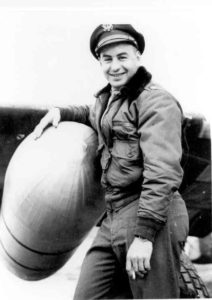
JG: How badly were you hit?
TH: We were not completely wiped out, but our losses were great. Several pilots bailed out over Bali. Two or three aircraft landed wheels-up on the airfield. A few went on and landed at Soerabaja. On first inspection, I thought my P-40 was without damage; so, expecting the Japanese to return, I planned to move it into the trees along the perimeter. But upon attempting to start the engine, I found a bomb fragment had left a hole through the propeller gearbox that I could put my hand through.
Fuch’s aircraft was completely burned out, except for wingtips and tail. One pilot, while trying to move his P-40 to safety in the trees, taxied into a bomb crater, leaving him with a bent propeller. Four of us took the prop from my unflyable plane, put it on his. None of us were mechanics, so we removed parts in sequence and installed them in reverse order. Since we lost all the fluid when we removed the prop, we were careful to save all the fluid from the other prop. We were really the blind leading the blind, but we fixed his P-40 and he flew it to Java. Later a two-engine aircraft arrived and flew the pilots with no aircraft to our base at Blimbing in Java.
JG: What was Blimbing like?
TH: Blimbing was a closed-down sugar plantation about 15 miles southwest of Soerabaja. We were housed in the workers’ quarters. Dutch wives took care of us—cooked the meals and cleaned the rooms. Shortly after the air raid another flight of 16 P-40s arrived. Those guys did something we did not do: about midpoint from Timor to Bali, over the island of Sumba, a Japanese reconnaissance plane (a Mitsubishi G3M2 of the 1st Kokutai, or naval air group, appeared over the flight. The P-40 leader ordered a section to destroy it. This was done, and the flight continued with the loss of only one P-40, which made an emergency belly landing on Sumba. The pilot was picked up and returned to his unit.
JG: What was it like fighting Zeros in the P-40?
TH: We were indebted to our veterans, who told us, “You’re not going to turn and fight with a Zero—you won’t live to tell about it.” Tactics were hit and run: if one had the altitude on the Zero, he could dive and get him. But engagement usually began with the Japanese above the P-40s so they threw the first punch.
JG: On February 20, the 17th was escorting seven Douglas A-24 dive bombers and a few B-17s on an attack on Japanese shipping at Lombok Strait, where they were jumped by Zeros of the 3rd Kokutai. Five P-40s were claimed by Naval Air Pilots 1st Class Yoshihisa Tojuji and Masao Matsuyama, and a sixth by Ensign Tsuneo Nakahara. Weren’t you among their victims?
TH: Yes, maybe the first. While the A-24s were making their almost vertical dives, I heard: “Break—Zero on your tail—break left!” I kicked that airplane hard left, looked behind and saw the sparkling gun barrels along the leading edge of that Zero’s wings. Then I heard a deafening crash as his cannon shells hit the tail and fuselage behind me. The canopy was dislodged an inch off its track, so I couldn’t crank the handle and I couldn’t budge the canopy. I was about 150 miles from base and knew I had to get home or belly-land the aircraft. I couldn’t bail out.
JG: How did you accomplish that?
TH: I did get home. And I knew that I couldn’t trim the aircraft. I extended my final approach and carried extra power. But the damage to the tail was greater than I realized. Flare-out was over a grove of coconut trees. As I eased the excess power, the tail dropped off. As the first jute fronds slapped across the windscreen, I turned power off and turned my had left (fighter pilots know the reflex to turn your head so your face is not into the gun sight.) I did see the propeller and gear box cart wheeling ahead, but I did not feel or was not aware of the impact when the tree trunk stopped forward movement.
When I awoke, guys were trying to free the canopy. Still dazed, I noticed there was no left wing—only the jagged tear where it had been bolted to the fuselage. I was taken to a Dutch hospital about 40 miles from Blimbing. I was more fortunate than some others. Maj. Sprague was killed and William C. Stauter crash-landed. Lieutenants Jack Dale and Joe Kruzel were each credited with Zeros in that fight, while Bill Hennon claimed a single-engine bomber.
JG: How did you get off Java?
TH: On February 26 a U.S. Army major woke me up in the hospital and told me I was to be evacuated at midnight. “I have to go back to the squadron to pick up my stuff,” I said. “There’s not time,” he replied, “so you have to decide what’s more important—your clothes or your hide. I suggest you be ready to leave at 12:00 as you are.” Since I still had stitches in my scalp, the doctor gave me medicine and a change of dressings. We boarded the midnight train for Tjilatjap. Natives were hanging on the sides and roof of the train cars. At Tjilatjap, we boarded the Dutch freighter Aberkerck and left for Australia on February 28. The Japanese amphibious landing along Java’s north shore began the next day.
JG: What did you do once you recovered from your wounds?
TH: After I was released from the hospital I was reassigned to the reactivated 35th Pursuit Group at Sydney as engineering officer. I was also one of the officers assigned additional duty as controller of Sydney’s air defense. The in May 1942 the 35th began its move to New Guinea. I was the group engineering officer and flew with the 41st Squadron. We were based at Seven-Mile Strip outside of Port Moresby. It was more of an offensive operation than Java—there were Douglas A-20 and Martin B-26 bombers. Bell P-39s and P-40s and B-17s staged through on their missions to Rabaul.
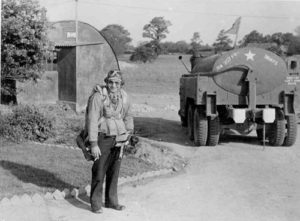
JG: What did you fly?
TH: In New Guinea we had P-39 Airacobras. It was a wonderful airplane on the ground. I’ll give Bell credit for going to the nose wheel—you could drive a ’39 just like a car, from the landing field to the hangar. Like the P-40, however, the P-39 had little high altitude capability and the Japanese were always above us. The P-39 was very demanding; its higher wing loading made it less maneuverable than the P-40. With the engine behind the pilot, it could easily spin flat or inverted. When you tried to pull tighter, you could get a vicious reaction—a slight vibration was the warning, then it could flip into an inverted spin and you had to go nose-down into a regular spin to get out of it. Of course, one needed altitude to go through that procedure.
JG: Did you do any fighting in the P-39?
TH: Very little dog fighting. Shortly after we deployed to New Guinea the P-39 was taken off all air-to-air combat. This was world-wide. However, the P-39s could be ordered to strafe a target and if enemy aircraft intervened there would, of course, be P-39s in air-to-air combat.
A good example of that occurred in July 1942, when the 35th was ordered to catch the Japanese standing down because of rain at their new airfield at Buna. The weather was bad in the eastern side of New Guinea. Fighter Command was convinced the P-39s could hit the target. The 35th got the mission. It was clear west of the Owen-Stanley Mountains. We let down on the eastern side south of Buna and hit the field flying 200 to 300 feet under the cloud cover. I destroyed two planes on the ground and got a Silver Star. The 35th went back in the afternoon but half the Zeros were in the air, resulting in both strafing and dog fighting. I recall times when I was on alert off the end of the runway, when ordered off, climbing and passing through 8,000 to 10,000 feet, when bombs were exploding on the target below. There was no chance to catch them, as they were nose-down, heading home.
The P-39 was great on ground support. The Russians loved it. While the P-39 was knocking out German tanks with its 37mm cannon, it was always covered by Yakovlev air-to-air fighters. Ours were also used in ground support. We would drop our bombs and strafe enemy ground troops.
357TH AND EUROPE
G: When did you make the transition from the Pacific?
TH: I came back from New Guinea in the fall of 1942 and was assigned to Hamilton Field to give pilots 20 hours of flying time in P-39s before they were sent to the Pacific. In May 1943 I went to the 357th Fighter Group that was halfway between activation and combat ready. The three squadron commanders had seen action in the Pacific. However, when the commanding officer of the 364th Squadron was killed in a crash, I replaced him. His misfortune was my good fortune.
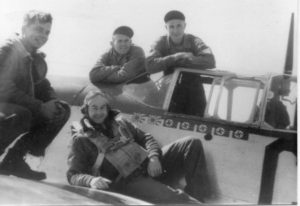
JG: Were there any problems during training?
TH: Not really. We were at about the end of gunnery training at Tonopah, Nevada. The squadron was coming along great. In aerial gunnery we fired on sleeve targets towed by another P-39. The rivalry was keen—pilots versus pilots and flights against flights. Bets were won or lost, usually a case of Coca Cola or beer. The next phase involved squadron tactics. The squadrons now operated from different airfields and would attack each other. Thee wee a number of accidents and pilots killed. Since it was happening in each squadron, headquarters relieved the group commander. Some of the newer pilots would push the P-39s beyond their capabilities. We eased off and slowed down the pace, and the accident rate was reduced. Our best move was from bases in California to airfields in Idaho, Wyoming, and Nebraska. Now we would make attacks on B-17 units. My squadron was based in Nebraska, a few miles from South Dakota, where we could shoot enough pheasant by sundown to feed the whole 364th. The evening steaks were served with breakfast.
JG: When did the 357th deploy overseas?
TH: Our sojourn in Nebraska lasted for a month, then we entrained at Camp Shanks, NY, and sailed on the liner Queen Elizabeth, arriving in Glasgow, Scotland, on December 1, 1943. Our airfield was not ready and there were no aircraft. We didn’t get P-51s until mid-January 1944.
JG: What was the situation in Europe at that time?
TH: Because of losses to the 8th Air Force’s B-17 and B-24 bombers over deep targets, the 354th FG, attached to the 9th Air Force, was put under operational control of the 8th, while the 357th was initially put on a 9th Air Force base. By the end of 1943 it was determined that there would be an invasion of the continent no later than June, but it could not succeed without air superiority. The 8th Air Force had never sued its available fighters effectively, and its commander, Maj. Gen. Ira Eaker, was replaced by Maj. Gen. James H. Doolittle. On touring his command, Doolittle noted a sign at one base that said, “The mission of this fighter group is to protect the bombers.” Doolittle said, “Take down this sign. And when I leave in 30 or 40 minutes, I want to see a new sign which reads, ‘The mission of this fighter group is to destroy the Luftwaffe.’”
JG: When did the 357th get into action?
TH: At the end of January 1944. We changed air bases and changed command, but ended up at Leiston, a town in Suffolk, close to the village of Yoxford—hence our nickname, The Yoxford Boys. Finally the planes started arriving—we were the second group to get P-51Bs. Over a ten-day period you never saw so many trucks coming and going. Squadron, flight, and element leaders flew alongside pilots of the 354th Group.
I flew on Maj. James H. Howard’s wing on January 30. During that mission, Howard spotted an Me-109 trailing the bombers, probably radioing their position to German fighter control. Howard passed the lead to his deputy and signaled to me. We peeled over and drove 2,000 or 3,000 feet. Howard, with great overtaking speed, opened fire at 500 yards and in seconds the airplane burst into flame. We then pulled back up and eased right back into formation. I don’t believe I moved the throttle on the maneuver. Nobody missed us—except the German pilot.
JG: When did the whole group go out?
TH: On February 11, Maj. Howard led the 357th on its first mission, a milk run to France. Then Lt. Col. Donald Blakeslee of the 4th Fighter Group led the 357th missions. With him, the group scored its first and second kills. Blakeslee, whose group flew Republic P-47 Thunderbolts, was so impressed with the Mustangs that after checking himself out in them, he went home and called is wing commander: “I gotta have those P-51s.” In my opinion, the great 8th Air Force fighter leaders were Blakeslee and Lt. Col. Hubert Zemke of the 56th Group.
JG: Which one did you prefer to emulate?
TH: Blakeslee really orchestrated his flights. He always knew where his three squadrons, six sections, and 16 flights were, though all were frequently changing positions. As needed, he moved his units like a maestro calling into play his strings, brass, and so forth. Zemke was more like a street fighter leading his gang across town to engage another gang. “Follow me! Do as I do!” When I led the 357th, I leaned toward Blakeslee, but when our group of 40 to 45 P-51s was about to engage 150 Germans, each squadron leader would be a Zemke.
JG: How did the fighters operate in the Eighth?
TH: Bombing formations ranged from 600 to as many as 1,200 bombers in three air divisions, each of which was comprised of from 300 to 350 bombers in box formations. The Germans generally made several head-on attacks against bombers unless broken up by our fighters. The first enemy attack was engaged by P-47s around midpoint of the mission. TheP-51s would assume the escort just before the Thunderbolts reached the limit of their range.
On a mission to Berlin, for example, there were 175 miles to “bombs away” and 175 miles on withdrawal. During that leg of the mission, we wanted to be up front so we could break up the Germans’ head-on attack. If we wee not up front we would miss the intercept. The P-51s flew well in advance of the bombers. There would be about 200 German fighters up and we’d meet ‘em with 35-40 aircraft, seeing how many we could shoot down. For five minutes, they’d be all over the sky and then, suddenly, there’d be nothing. The Me-109s would try to better their position by climbing, while the Focke-Wulf 190s would generally dive to the deck. When the fight was over, we all would join up with our bomber division and resume escort.
JG: When did you score your first air-to-air victory?
TH: On February 24, 1944 I got a probable on an Me-109G last seen spinning inverted ten miles northwest of Gotha. The first confirmed one was on March 2. Four of us were on our way home north of Frankfurt when I saw two single-engine fighters attacking the bomber box. We dropped our auxiliary fuel tanks and dove. The Germans dove and split at 9,000 feet. I and my wingman took the leader—twice he tried to turn into use, but we outmaneuvered him easily. I hit him, he went into a shallow dive and crashed in a wooded area. My element leader, 1st Lt. John B. Carder, got the other one. He must have hit the pilot because the aircraft continued in a shallow dive, crashing and breaking upon the main street through the town. My report was later translated in the Illustrated London News making me the “Julius Caesar” of my age: “We saw two, we engaged two, we destroyed two!”
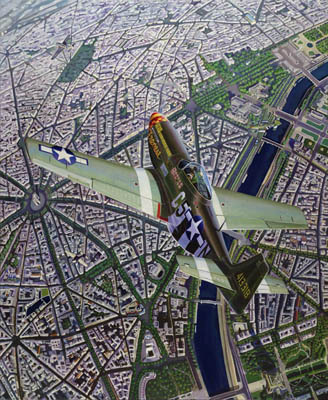
The Boulevards of Paris by Troy White
JG: You must have finally come into full stride, because you scored your next success only four days later.
TH: The March 6 mission to Berlin was our first big raid after two aborted sorties. The 357th was to pick up B-24s of the 2nd Bomb Division around Magdeburg, but we had lousy weather and when it got to rendezvous time I assumed they were late, so I continued toward Berlin. Coming upon the initial point, one of my boys called out, “Bogies at two o’clock!” Immediately someone called “Bombers at ten o’clock.” It was a three-way rendezvous. We engaged the Me-109s, Me-110s, and FW-190s between the initial point and the target, and we took them on in an air battle that descended to the rooftops of Berlin.
I went after the leader of the initial enemy group. He decided to fight and we engaged each other at 28,000 feet. As I was gaining position on his rear, he rolled over and dove for the deck with me in pursuit. In the dive we both hit compressibility. At around 10,000 to 12,000 feet he was able to turn while I still had no control and lost him in the smoke rising from defensive smoke generators around Berlin. Then something swished by—a stick of bombs, looking like rungs on a ladder. I looked up and all I cold see were four-engine bombers. I rolled over and dove straight for the deck to parallel the falling bombs, leveling out over the rooftops, then headed for the nearest open area.
JG: You didn’t get that 109, then?
TH: No, but I got together with my flight and as we were climbing to resume escort, I spotted a low-flying Me-109, apparently coming down to land. I caught him on final approach and he crashed and burned on the runway. My flight of five made one strafing pass on parked aircraft and the control tower.
JG: Two days later you were credited with a twin-engine Me-410. How did that come about?
TH: We were on our way home from Berlin when I spotted an Me-410 from 23,000 feet. I dove and at 2,000 feet I was closing on him from astern when he started a slight dive. I opened fire when my ring sight was centered and his entire right wing tore off at its root. He crashed from 500 feet, starting a great fire on the ground.
JG: What about your fourth victory?
TH: On March 16 I was leading a four-ship flight that had an engagement with Me-110s and Me-109s. Four 110s made a sorry attack on three boxes of B-17s with no result. We attacked, they broke up, and I went for one Me-110 heading south, along with Capt. George Currie. We caught up with it without diving, and at 300 yards I opened fire. My second burst started the left engine burning and the 110 straightened out. I saw his canopy opening, went under him and noticed that both of his engines were burning. I broke away and saw one parachute as the110 crashed.
JG: What were the circumstances on the mission you became an ace?
TH: On April 19 we were about 33,000 feet over the target when 20 German fighters attacked a small straggling box of bombers south of Kassel. We shot down five of them, including a 109 for me. By that time I was deputy commander to the group. The CO of the 362nd Squadron, Lt. Col. Hubert I. Egnes, had become deputy group commander in March, but on the 28th, while he was strafing an airfield in southern France, his plane was hit by AA fire, hit the ground and exploded. I then became deputy CO and was promoted to lieutenant colonel on April 30.
JG: Was the 357th involved in any special activities with D-Day coming up?
TH: During May 1944, VIII Fighter Command was giving maximum assistance to the tactical forces. On May 21 we participated in Operation Chattanooga, which involved “working on the railroad.” We were also strafing highways, airfields, and canals. Each group was given a grid of German territory to work over, and attacking transportation was number one priority. On Sunday, at H-Hour—11 a.m.—all fighters in England hit the deck in their respective areas. You can imagine the psychological effect.
That night we heard “Lord Haw-Haw,” the British turncoat William Joyce, announce on Radio Berlin: “Tonight we’re putting our finger on the Yoxford Boys. They show absolutely no consideration for women and children as they strafe Germany. Today the 357th strafed two trains at Rostock, which were moving women and children from bombed out homes in Berlin to camps on the Baltic.” Whatever the truth to that charge, the next day a 364th Squadron pilot, Thomas L. Harris, bellied in, and only the German military saved our Yoxford Boy from an enraged farmer. On May 24 I led the group to Berlin and on May 28 I downed an Me-109 northwest of Magdeburg.
JG: Didn’t you run into a new German fighter in May?
TH: During a mission over the Munich area I had four planes with me at 20,000 feet when we engaged what I assumed was an FW-190. When he peeled out and dove for the deck, I was still out of range but I told my pilots, “We’ll get him on the treetops,” and we dove after him. The 190 settled out, heading east, and I spread out my flight, left to right, so we’d have him if he turned. He was still pulling away, however, so I put my flight on military power—maximum speed, which we could only sustain for five minutes due to engine strain—but he continued to run away from us. After five minutes I called it off and we returned to our bomber escort duty.
JG: Did you find out what model of FW-190 that was?
TH: One night at the 1992 air show in Oshkosh, we were having a barbecue and a few beers with six or seven Luftwaffe pilots and this story came up. They were most interested in details—time, place, all the rest of it. When I told them all I remembered they became very excited, jabbering quickly in German, laughing, and shaking their heads. They explained that one of their colleagues was on leave from active duty, on special assignment to the Focke-Wulf factory to test-fly a new aircraft, the FW-190D. I left thinking that they’d let me know if they found out more, but that never developed. All I really recall was that baby was going—he left us behind in no time at all.
JG: What did you do on June 6, 1944?
TH: We were expecting the worst, and again it was maximum effort. The 9th Air Force was working over the French coast. Our group was given an area 200-300 miles south of Cherbourg. The first mission was at 1 a.m., stooging around at night with no visibility and everyone spread all over. We ended up literally flying over the invasion area. I didn’t fly until the afternoon—the group CO, Col. Donald Graham, led the first and third missions. There were no Germans in the air and nobody fired their guns. As it turned out, the Germans had moved all their aircraft into Germany because of the intense air war during the previous three months. I flew another milk run mission in the afternoon. We were available on call but never got called. I believe there were only two German aircraft in the area on D-Day.
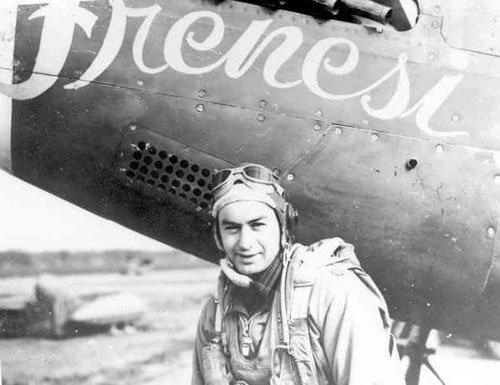
JG: What about the occasion of your next aerial victory?
TH: By June 29 the 8th Air Force had reached a point where it had 14 P-51 groups and Zemke’s 56th Group, still using P-47s. The 357th was the spearhead, providing cover for the lead bomber division to Leipzig. At the rendezvous I checked in right over the lead bomber of the first division. We were about 40 miles ahead of the division and about to circle back to repeat the racetrack pattern. We were just into our turn when somebody said, “Bogies, two o’clock.” The German had a choice: head for the bombers or turn into us. He apparently saw no alternative except to fight.
We got 21 of them, while no bombers were lost due to enemy aircraft, for which the 357th got its second Presidential Unit Citation. Between them the three P-51 groups were credited with 48 enemy aircraft on June 29. It was a beautiful mission except for the loss of one pilot, my wingman 1st Lt. Richard C. Smith. I was concentrating on an Me-109 and after I shot him down I looked around and found myself bare-assed naked. Smith was probably protecting me when he was shot down by another German and either killed in the cockpit or in the crash. As I was coming home I shared the destruction of an Me-410 with 2nd Lt. Merle F. Allen of the 364th Squadron.
JG: How about your last victory?
TH: That was during a raid on Valence, 50 miles south of Lyon, on July 14. The 56th’s P-47s were escorting the bombers and my three squadrons were each on their own, covering the area. The 364th engaged ten Me-109s making an attack on the last combat wing of B-17s. We destroyed four but the other six escaped.
JG: When did you leave the 357th?
TH: I flew my last mission on August 11, 1944. I stayed in the USAAF—they offered me a regular commission, which I couldn’t accept fast enough. They sent me back to school to complete my degree. Between 1945 and 1965 I was associated with air defense and fighter operations. I fought the Korean War at the War Plans Division. The most advanced military plane I flew was the Convair F-106, while I held command of Minot Air Defense Sector, North Dakota, in 1962. I was promoted to brigadier general on August 27, 1965, while commanding the 86th Air Division in Germany. I retired on February 1, 1970.
Jon Guttman is editor of Military History, senior editor of World War II and Aviation History magazines, and the author of Fighting Firsts from Arms & Armour Press.
This interview was published as “From Bali to Berlin” in the February 2001 issue of World War II Magazine and was written by Jon Guttman. It is presented here with permission from Jon Guttman and Bill Breidenstine of The History Net, Where history lives on the web.

